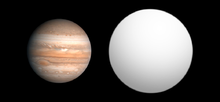WASP-19b

WASP-19b is an extrasolar planet. It has one of the shortest orbital periods of any known planet. Its orbital period is approximately 18.932 hours. It is much 1.31 times larger than Jupiter. It orbits the star WASP-19 in the Vela constellation.[1] In December 2013, scientists working with the Hubble Space Telescope found water in the atmosphere of the WASP-19b.[1][2]
References[change | change source]
- ↑ 1.0 1.1 Hebb, L.; Collier-Cameron, A.; Triaud, A.H.M.J.; Lister, T.A.; Smalley, B.; Maxted, P.F.L.; Hellier, C.; Anderson, D.R.; Pollacco, D. (2010-01-01). "WASP-19b: THE SHORTEST PERIOD TRANSITING EXOPLANET YET DISCOVERED". The Astrophysical Journal. 708 (1): 224–231. arXiv:1001.0403. Bibcode:2010ApJ...708..224H. doi:10.1088/0004-637X/708/1/224. ISSN 0004-637X. S2CID 119189785.
- ↑ Mandell, Avi M.; Haynes, Korey; Sinukoff, Evan; Madhusudhan, Nikku; Burrows, Adam; Deming, Drake (2013-12-03). "EXOPLANET TRANSIT SPECTROSCOPY USING WFC3: WASP-12 b, WASP-17 b, AND WASP-19 b". The Astrophysical Journal. 779 (2): 128. arXiv:1310.2949. Bibcode:2013ApJ...779..128M. doi:10.1088/0004-637X/779/2/128. hdl:2060/20140016974. ISSN 0004-637X. S2CID 52997396.
